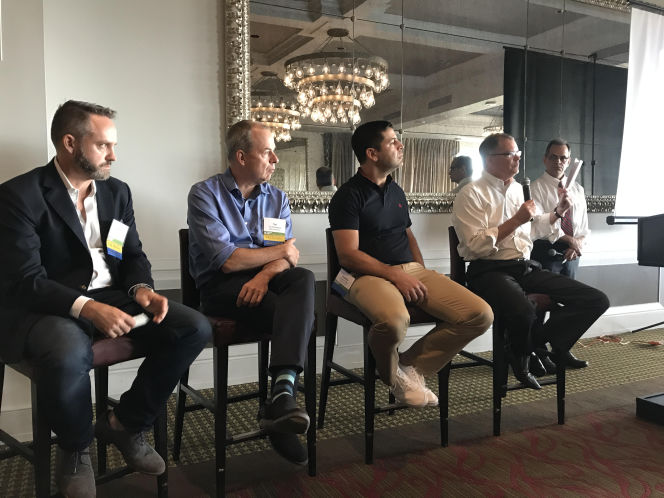At yesterday’s StimULI Tampa Bay Breakfast, hosted at The Birchwood on Beach Drive, our very own Richard Hughes had the opportunity to speak on a panel to discuss the topic of “Designing & Developing a District”.
Each of the speakers gave their interpretation of what a district has become, to start. This sold out event had a well-represented spectrum of speakers, including an architect, a designer, a developer, and an investor – all emceed by the President of the St. Pete Chamber, Chris Steinocher.
There were plenty of conversations flowing and opinions heard. We were honored to be a part of it. Below is an article featured in the Tampa Bay Times, written by Robert Trigaux.

ST. PETERSBURG — Is it this city’s extraordinary waterfront? Still more museums on the way? A spreading arts community? Downtown’s housing boom?
Or perhaps the sheer concentration of all this, and more, in one walkable downtown?
Nobody knows for sure why downtown St. Pete is thriving at a level not seen in a century or more. But whatever mojo is at work, city, business and arts leaders gathered Thursday are sure about one thing:
Don’t kill the goose that lays these golden eggs.
“St. Pete is a hot property and we do not want to screw it up,” says a savvy Chris Steinocher, a 30-year resident, longtime economic development executive and – for the last six-plus years – CEO of a reinvigorated St. Petersburg Area Chamber of Commerce.
Atlanta? “They screwed it up,” admits Steinocher, himself an Atlanta native, of the South’s most sprawling, traffic-choked city. Let’s not follow in their footsteps.
That was the core message explored by five St. Pete leaders during a panel at a sold-out Urban Land Institute event held at The Birchwood on the city’s Beach Drive.
It was a lively chat with some genuine insights and ambitions. How, for example, can the city spread downtown’s success out to St. Pete’s “districts” — 16 in all? They range from the Edge, Grand Central (the beneficiary of major zoning changes by the city) and Innovation (clustered around USF St. Pete and Johns Hopkins All Children’s) all the way south to the recently conjured Skyway Marina District anchored by employers like Ceridian and Jabil, as well as Eckerd College and Maximo Marina.
Richie Hughes of Clear PH addressed the importance of branding some of the districts of St. Petersburg. Branding is essential, Hughes said, but it will take time for some districts to better define what they are. “The most important thing to do at first is to get local people to buy in,” he said.
Well-known urban architect and longtime resident Tim Clemmons, principal with Mesh Architecture, compared and contrasted the progress of St. Petersburg and Tampa.
“St. Petersburg’s gift is that is concentrated,” Clemmons says, in a smaller, walkable downtown.
Tampa’s probably made even more progress in more ways, he said, but its gains are spread out among downtown, Westshore, Ybor City and farther-flung neighborhoods and communities. That makes it harder for Tampa to connect its successes together and reap the combined reward.
Steinocher, riffing a bit off themes found in St. Pete author Peter Kageyama’s 2011 book “For The Love of Cities,” says St. Petersburg benefits from its “culture of passion” where many residents know each other and try to support one another.
“Is that too sappy?” Steinocher asked. Well, he quipped: “Get sappy.”
The chamber has endorsed an economic strategy dubbed “Growing Smarter” that tries to get the city’s community, represented by more than 70 organizations, on the same page and working together.
“This is an old method of getting people together,” Steinocher said. “We’re focused on jobs, entrepreneurs, training workers and the funk of St. Petersburg. We want the artist, the creatives, the tattoos, the murals. And in order to do that we have to show everybody that they fit.”
The city’s influential chief economic development official, Alan Delisle, suggested a city’s downtown must be vibrant before other things can happen. He described it as the “heartbeat” that spreads wealth and investment.
Don’t assume, however, that this panel was picked just to sing Kumbaya.
Developer Jonathan Daou of Eastman Equity brought his perspective and expectations from New York City where he pursued creative approaches to Manhattan living. St. Petersburg caught eye around 2010 and he has since bought land around the downtown area, especially in the city’s Edge District bounded by Dr. MLK Jr. (9th) & 16th Streets and 1st Avenues North and South.
Recalling the bohemian success of Manhattan’s SoHo district, Daou celebrated the importance of the artistic rebel and cool factor for cities. He argued how important it is to let creative people have the freedom to do their own thing without an excess of rules and oversight. He cautioned, with a glance at city official Delisle, against the desire to create regulations if there are no obvious problems to fix.
Panelists agreed St. Petersburg, situated on a peninsula bounded on the east by Tampa Bay and the west by the Gulf of Mexico, faces growing pains ahead. How big should the city get? How tall should its buildings get? Keep in mind it’s already blessed the current construction of “One St. Petersburg” a block off of Beach Drive, that will soar 41 stories when completed.
“Growing pains are difficult. St. Petersburg will become a big, cool city,” predicted Daou. “If there are too many attempts to freeze growth in St. Pete, he joked, “let’s go to North Korea.”
Architect Clemmons suggested St. Petersburg’s challenge is to figure out how to unleash more of the downtown’s success to other parts of the city. Some districts are feeling constrained by city rules restricting growth. “I think it’s time to challenge some of those assumptions,” he said, by taking a broader urban approach to some of the districts.
Delisle did not necessarily disagree with any of these points of view. This is the give and take of all growing cities.
Delisle’s final take? How do we preserve the uniqueness of St. Pete? “We’re here about the authenticity of St. Pete.
“We’ve got to be careful with it.”
Contact Robert Trigaux @tampabay.com. Follow @venturetampabay.
What are your thoughts on the designing and development of our city? Some notable quotes from the breakfast panel are listed below.
“Attention to detail and welcoming environments are keys to creating strong districts.” – Tim Clemmons, Mesh Architecture
“Location used to be the key to successful real estate, now it’s staying power.” – Jonathan Daou, Eastman Equity
“Inclusivity and diversity foster economic development and help attract the workforce.” – Chris Steinocher, St. Petersburg Chamber of Commerce
To keep up on the ULI Tampa Bay’s events, visit their website.

